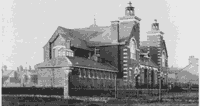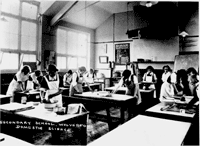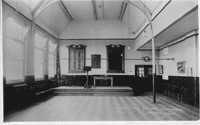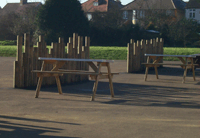'Formerly the class in conjunction with the Wolverton and District Higher Education Centre, were held at the Science and Arts Institute, but the school has a separate building worthy of it. It is situated in the convenient spot in Moon St., and it is very attractive and well-designed structure, being built of red brick with white stone dressings..... It has accommodation for one hundred and sixty scholars, and the building has been so arranged that extensions can be added when required.' (Wolverton Express 1907?)
Mr Boyce (the Headmaster when the school opened) had reported in 1906 that the school would not be big enough with a rising role and so an extension was built on in 1908 and the school could then accommodate 135 pupils. The original building was designed so that additions could be made as required.
In 1909 a railway carriage was purchased at a cost of £10 to be used as a bike shed. This served its purpose until 1920 when it was removed - by that time a cycle shed to accommodate some 100 bicycles was needed.
There was trouble for the caretaker in 1912 - whenever there was wet weather he had to pump out water from the basement.
With a growing intake, it was agreed in 1911 that an Eastern wing would be built with two large rooms for manual instruction and a gymnasium as well as a room for the Headmaster on the upper floor. It was completed in 1915 along with separate block for domestic science (cookery, laundry and housewifery). This meant the purchase of additional desks (@ £1 and 5/= each - about £1.20) and equipment for teaching cookery and laundry skills.
In 1916 trees were planted in the grounds and the following year the gymnasium was kitted out.
There were fluctuations in the school role due to uncertainties about employment at the Works and an increase in the fees which was too much for some families. In January 1914 the number of pupils had fallen from 261 to 225 in one year. When the fees were reduced, the role went back up. By 1919 there were 272 pupils on role and the school needed to expand again. The manual instruction room and chemical lab were used as classrooms in the meantime and a decision was made that pupils under ten years would no longer be admitted.
A further 7.4 hectares on land was purchased for the school in 1920 (at a cost of £1500). This increased the playing fields even further but work had to be carried out to level the fields. In January 1922 the School Minute books record how 6 men who were labouring on the fields were dismissed for not working properly. The problems with the fields continued and they were often waterlogged until pipes were laid to drain them in 1927 (at a cost of £31 and 4/=). Further improvements were made to the outside areas with the tar paving of some of the hockey pitch and the asphalting of the path from the main buildings to the hut in 1928.
With the increasing advent of 'mod cons' the school was updated with the electrical wiring completed in 1927 (at a cost of £96 and 16/=) and in 1930 hot water was available in the lavatories. There was considerable excitement with the installation of an electrical cooker in 1930 which meant that school meals could be cooked on site.
Early 1931 saw the corridor of 'the hut' (this temporary structure had been erected at the end of the netball court during the first world war?) seriously damaged by fire. It was caused by a paraffin heater. The hut housed three classrooms and the woodwork room.
The extensive grounds were largely given over to pitches, courts and tracks. Alan Sanders recalls an A pitch and a B pitch for football - he injured himself on th 'B' pitch which proved very treacherous. In October 1933 the Lime trees were pollarded.
At some point around 1940 the separate staff rooms for men and women teachers were knocked through to make a larger combined room for both groups.
1940s During the war a 'prefab' was erected near to the school gate (where the current caretaker's house is found) to accommodates three extra classrooms. At this time there was also a bike shed to the right of the Moon Street entrance. Some of the land was also given over to allotments for growing food.
The history of the school gets a little confusing at this time with changes in designation We would really appreciate any help clarifying this. An HMI report written in 1954 indicated that in 1946 the school was reorganised as a Junior Mixed (on the upper floor) and a Secondary Modern School on the ground floor . The Schools had separate Heads.
It appears that the Senior school was then designated as a Grammar School (with no juniors) and in turn the Grammar School was amalgamated with the Technical Secondary School in 1958 and renamed Radcliffe School. This Bilateral school moved to its current campus in Aylesbury Street West 1961 and in 1968 Radcliffe became a comprehensive school - the first in Milton Keynes). Whilst these interim arrangement were in place
Glenda Flynn remembers that some pupils were boarders at Wolverton House (now a public house) - especially the children of military personnel.
A swimming pool was built in the grounds of the Moon Street School at about this time (c.1940). It was only small and unheated so it was only used in the summer months. In 1972 this swimming pool was provided with a cover and a memorial plaque to Brian Craddock who had been a popular teacher who had drowned in tragic circumstances in Bradwell in 1979.
In 1972 the school changed from a Junior to a Middle School. There were some 320 children aged between 8 and 12 years but the role dropped when Greenleys school opened and some pupils moved there.
During the 1970s the hall of the old school was converted into the library and the gym became a classroom.
Mr Speaks (the Head) created a wildlife garden at the edge of the fields near the railway line also recalled by Si Phillips.
In 1998 the School appointed a new Head, Sue Cox. When asked in the interview what one of the first changes she would make to the school would be, she said that she would throw out the old battered furniture and give the children desks and chairs that they could be proud of. This she did as well as improving the environment by introducing curtains, blinds and carpets as the budget would allow.
Over the following years there were further improvements to the building and grounds with the demolition of the old open air swimming pool (1999), the demolition of the old toilet block (19??), lowering of some of the ceilings (where) to improve the acoustics for teaching and groupwork, planting in the gardens and climbing equipment in the playground.
There is a problem with the roof in heavy downpours with the library flooded on a couple of occasions as the water collects in a gully between two parts of the building and then seeps in.








